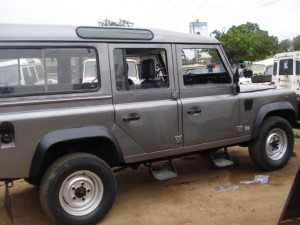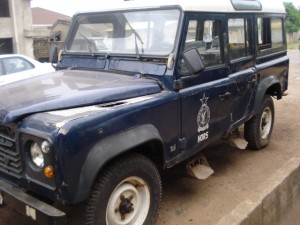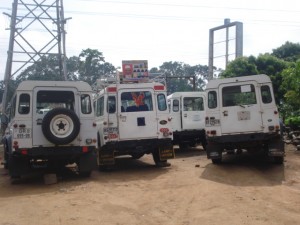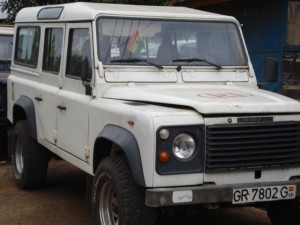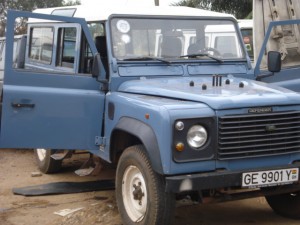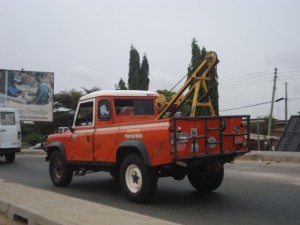To date, apart from a few things procured locally, the primary source of parts to rebuild our 1995 Landrover Defender has been two shipments from Famous Four http://www.famousfour.co.uk/ in England. This is how we got almost all the brakes and clutch parts, the rear half axles, the wheel bearings, the tie rod ends, the door seals, the aluminum chequerplate panels, the heavy duty shocks, etc. Those shipments came into Ghana with greater ease and speed than I had expected in March and April, delivered to the front door of the embassy within two weeks of sending from the source.
I started compiling a list of things for a third shipment in June to cover a few mechanical pieces that I had missed in the earlier shipments, as well as some interior and exterior finishing pieces. The third shipment is relatively small and includes relatively inexpensive, yet vital pieces that are not available or are very expensive locally. It includes: the fuel sender (the piece in the tank which which measures the fuel level for the fuel gauge which I discovered had been removed from this vehicle at some point); the bonnet release cable and device; a handbrake cable that is too expensive here; a new set of floor screws, tie rod ends (that I should have ordered the first time); and some mechanical pieces like bushings for the rear A-frame that were not part of the bushing kit I got in the first shipment. more body pieces (aluminum chequerplate for the hood, screws to tighten up some of the body plates, new exterior lights to replace the old ones that might work and look OK now but will look really old when we repaint the body. I also bought new front seat foams and covers from Exmoor Trim in England (www.exmoortrim.co.uk) . One of the reasons why I wanted to do our own vehicle is that I did not like the way they did the interiors here, the seats were particularly frightening. However, this shipment did not include any soundproofing even though much of the delay in finalizing the order resulted from my own indecision about the various options for the stuff. In the end I concluded that all things considered England would not be the optimal choice for soundproofing for us(see separate “sound reduction puzzle” post).
This shipment has demonstrated how the reliance on externally-sourced parts makes my schedule vulnerable to delays beyond my control. There were already delays due to my own indecision and effort to include as much as possible in this shipment before finally finalizing the order in late July. When mid-August came and I had not heard anything I went back to Famous Four to ask for a sitrep. The next day I received a phone call from TNT in Ghana to say the shipment had arrived in Ghana but was being held in at the airport by the Customs and Excise and Preventive Service (CEPS) and that I would need to present myself at the airport in order to clear it. This had not part of the process in any of the previous shpments, neither of the two Famous Four shipments or the early investment in outfitting gear we had shipped back from South Africa last December incl. a mobile fridge before we even owned the vehicle. I have to wonder how long the things had been in Ghana before TNT deemed to phone me, perhaps prompted by a call from Famous Four. As it turns out this was just the beginning of series of problems with both TNT and CEPS that would combine to seriously delay the delivery of this shipment.
I took a morning off work to go to the airport cargo area and on arrival at the entrance was besieged by people asking where I was going, one fellow just got into my front seat uninvited and said he would show me where TNT was. It turns out everyone there is looking for a cut in the process. When I got to the TNT office I was informed that I had to pay a “handling charges”, even though my shipping fees with Famous Four were to take it to the door. DHL, who had handled the two previous shipments, had on both occasions delivered the goods no problem to the High Commission without delay. I declined paying the handling fees and left the airport and sent a message to Famous Four to seek clarification about shipping/handling costs. The next day I got a phone call from a manager at the local TNT office (with a strong British accent) to apologize for the confusion, there would be no handling fee, but I still needed to clear Customs.
A couple of days later I went back to the airport and went through the same process of having someone jump into the front seat. This time I was well received at TNT by the same person who had asked me for the handling fee the previous occasion, who this time just escorted me to the small office of a CEPS officer at the end of the warehouse. Despite the modest office the CEPs officer had an air of assurance and authority and people around certainly deferred to him. After we were introduced he looked at the documents the TNT person had given him and asked if these car parts were for official purposes or my personal use. I decided it would be tough to convince him these were official auto parts and indicated it was for my personal vehicle. He said that even though I was a diplomat entitled to duty-free import of personal possessions, how did he know I did not have a Ghanaian girlfriend I was bringing in car parts for? I said I did not appreciate being accussed of abusing my diplomatic privilege, that I was obliged to respect laws and protocol, just CEPS was obliged to respect the Geneva Convention. He said that since this was for personal not official use I would have seek the approval of Ghana’s the Ministry of Foreign Affairs. I was not sure that was true but it did not seem totally improbable and I decided there was nothing to be gained from challenging him and said I would be pleased of course to follow any required procedures. While he was telling me about the procedure I had to follow, he also wanted to impress upon me how long the procedure could take, as if I had some choice.
The reason for his making the point about how long the process could take became clear only after I had agreed to go for MFA clearance and left his small office at the end of a warehouse and was walking acrosss the yard. As I neared my car I was approached by a fellow I had noticed in the warehouse when I first came in. He repeated the Customs agent’s refrain that it could take a long time to obtain the clearance, but that he thought I could get the goods that day if I was prepared to pay the duty. I asked if he knew how much the duty would be. He said 250 cedis, the equivalent of about $170. I don’t think my shipment was worth that much, and the fact that I was having this conversation in the parking lot with a fellow in jeans and T-shirt, who also asked me how much I wantd for my Subaru Legacy that we were standing beside, helped me realize that I had just been asked for a bribe.
For better or worse, I have had a long-standing personal and professional commitment against paying bribes. In my experience this has been the position of Canada’s Department of Foreign Affairs (DFAIT) and of CIDA where I work, and I am no stranger to waiting out delays required to clear our personal effects upon arrival in other postings because we don’t pay bribes. I declined the offer of paying the “duty”, saying I preferred to do it properly. Interestingly, about the same time as we were trying to clear this shipment newly-arrived diplomatic staff at the High Commission were also being subjected by CEPS to unusually long delays in processing their personal effects at the Tema Port, in at least one instance there had been an approach that sounded like a request for a special payment. Despite Ghana’s relatively positive governance image when compared to other African countries, corruption remains a significant development challenge. Certainly corruption persists within CEPS.
Later that day when I spoke to CHC Admin they said indeed it was not out of order for CEPS to ask for MFA clearance and this was part of CHC Admin’s duties. It would take a couple of weeks to get it. Fortunately CHC has the knowledge of the process and people to facilitate this and I was hoping to get my hands on the goods just before Laura and I were scheduled to depart for a two-week Egyptian vacation. We got the clearance about three weeks later and TNT came to the CHC to pick up the formal approval MFA and presented it to the CEPS officer at the agent. By 7PM on the Friday of the weekend we were scheduled to leave it was delivered to our house. On Saturday I was able to get the parts and vehicle to Opere’s shop under the tree where he, Paani the “welder”, and Eric the electrician were able to work on their respective pieces while we were out of the country.
The implications of the problems that I had with this shipment are not limited to the delay of more than a month. I now have a much more cautious attitude toward any future shipments and will be more willing to source second hand or more expensive new parts locally rather than importing and risking having to deal with CEPS again. Fortunately the only offshore things we still need are a few items for expedition outfitting. I was able to get some from Offroad Egypt(separate post coming), and we should be able to pick up most of the rest of what we need on a shopping trip planned to South Africa at Christmas and bring it back with us.
As I write all the mechanical parts have now finally been installed, Phase I of the electrical work is underway (separate post coming) and Paani has finished the pre-paint body work.

